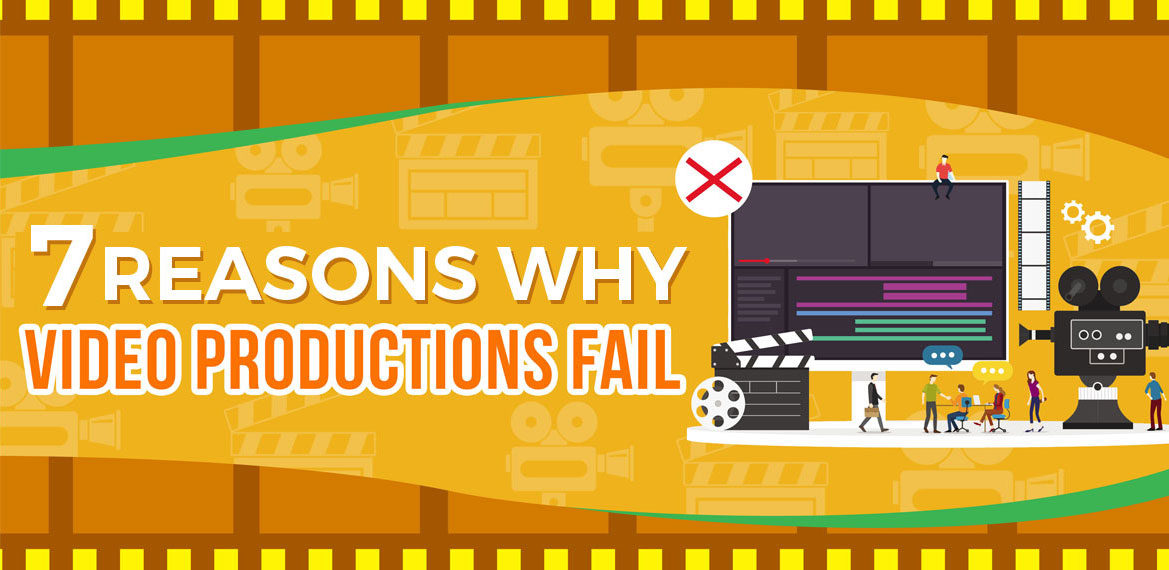Video productions that are considered industry failures are those that don’t generate any buzz or impact brands in a negative light. They are often those skipped or left unnoticed. They can even be shunned by the public because they just aren’t interesting or they send the wrong messages.
But no matter how many unsuccessful videos there are, several videos have still risen to popularity and have given brands the boost they needed. How? By keeping up-to-date and avoiding the industry’s known downfalls. In order to find ways to succeed in a video campaign, you need to understand the factors that can make or break video productions. To help you, here are 7 reasons why videos fail and what mistakes to avoid to produce a good video.
7 Reasons Why Video Productions Don’t Make the Cut
1. Poor Pre-Production Planning
Pre-production is one of the most crucial steps to video productions. While nothing is filmed or edited at this state, it is important to create a full-proof plan in order to come out successful in the end.
Little or rushed planning can affect the entire production process in more ways than one. An unsure timeline, a rushed shot list, a poorly improvised script, or an unrealistic schedule can compromise the quality of the final outcome.
2. Low Production Value
Videos have to look and sound good in order to look appealing. Poor quality in one or both aspects devalues the message it sends out. So when a product or service is featured in a video with low production value, it loses its credibility.
But hey, don’t blame the budget. The production value is the result of how videos are presented rather than how much it costs to make them. In fact, there are several videos made on a tight budget that turned out great. Failed video campaigns are a result of companies biting off more than what they can chew. If the budget can’t handle cool special effects, then switch the concept. It’s the better option than putting out a video with cheap animation that devalues the production.
3. No Understanding of Target Audience
The target audience is one of the most important aspects to consider when making the video. After all, the entire purpose of producing the video is for them to see it. Video productions won’t succeed if you don’t know what interests them and how to capture their attention.
Videos with vague messages may also indicate that the product or service featured could be “sketchy” or “too good to be true.”
4. Mediocre Creative Choices
Overdoing the vibe for the target audience can put any video on the top ten most “cringeworthy” videos. When productions overexaggerate when trying to become relatable, it can hurt the brand’s image. Instead of leaving a positive impact on viewers, it becomes something they would avoid watching.
These choices also play a role in the overall emotional impact that the video is going for. Hard sell videos can go straight to the point, providing all the facts and benefits creatively tailored to its target audience. Soft sell videos like to tap into the narrative realm, taking your audience on a journey before presenting the service or product. Choosing which way to go can also determine the success of your video production.
5. Lack of Originality
Videos that are way too cliche and is something that viewers have seen before create no real impact, making them forgettable. But with millions of videos released every day, it makes sense that videos that are copycats of other videos don’t make it big.
Successful videos either create something entirely different or give a spin to an existing concept. But videos with the same concept and execution of other successful productions will easily bore anyone and won’t compel them to watch.
6. Doesn’t Make Sense
Videos need to have a clear message that they can get across in a simple yet creative manner. Failed productions can be a result of people not entirely sure what the video was about. They may not even have caught what it was selling.
7. No Call to Action
If a video doesn’t translate views into sales, then it could be considered a failure. It is not enough to present the message. A video needs to urge consumers to avail of the product or service, whether directly or indirectly.
Details are also important in videos. If the audience has no idea how to contact the brand or where they can find them, then it will affect the video’s success. There needs to be a balance as to what details you choose to put on a video in order for it to succeed.
Successful video productions find the right balance between presenting the brand in an interesting manner and informing target audiences of their benefits. To get started on your campaign, it is important to take these tips with you to make sure that you can drum up the positive press you need.
ALSO READ: 10 Reasons Your Startup Should Invest in Video Productions
Having trouble producing a video campaign on your own? Mustasa Republic is a reputable multimedia company with years of experience well enough to know how to create successful video productions. Contact us for more details!

